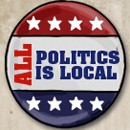Trucks vs. Neighborhoods: Who comes out on top?

It must be tough to tell west Vancouver residents who are upset about heavy truck traffic in their neighborhood to sit tight while the city studies the problem.
Especially when those residents are so irate that they threaten to get militant.
“I’ve had it. I’m ready to sell. You’ve taken the livability of my neighborhood and turned it into a big pile of dung,” 39th Street resident Greg Martin told the Vancouver City Council on April 27, following a frighteningly close call between a big truck and a little girl on a bike. “I’m going to start throwing rocks. I’m going to start throwing wood in the street.”
Truck traffic increased on 39th Street following the November 2010 opening of a $19 million bridge the state built above a network of railroad tracks. To the dismay of Lincoln Neighborhood residents, the bridge and upgraded roadway proved to be one of the fastest routes from Interstate 5 to the industrial area along Fruit Valley Road and the Port of Vancouver.
The City Council is sympathetic. As Mayor Tim Leavitt put it at an April 6 council workshop, “The livability of our community is more important than a truck driver saving five minutes on his route.”
Residents wanting the problem solved yesterday are in for disappointment. Trucks may speed, but the wheels of government turn slowly and deliberately.
In February, the city launched a study to determine how Vancouver’s four arterials (39th Street, Northwest 78th Street, Mill Plain and Fourth Plain Boulevard) could manage freight traffic needs while preserving neighborhoods.
The city is collecting traffic data to analyze traffic patterns, points of conflict and street capacity. Community outreach is starting soon. On Saturday, May 30, from 9 a.m. to noon, the city is hosting a community forum to discuss its Westside Mobility Strategy. Then, at a June 15 City Council workshop, city staff will present preliminary findings from the data collection and transportation analysis. More community outreach will be conducted throughout the summer and fall.
The goal is to “develop a network strategy to address and manage conflicts and optimize opportunities” and recommend strategic improvements for neighborhoods and industry by the end of this year or early next year, according to an April 6 staff presentation.
Until then, pedestrians and cyclists should take extra care on 39th Street, and truckers should keep an eye out for rocks and wood.
